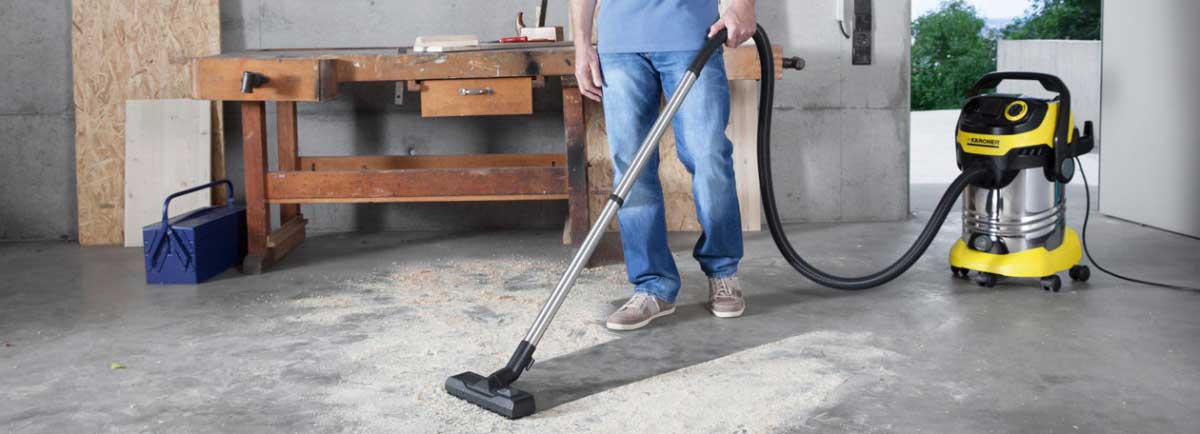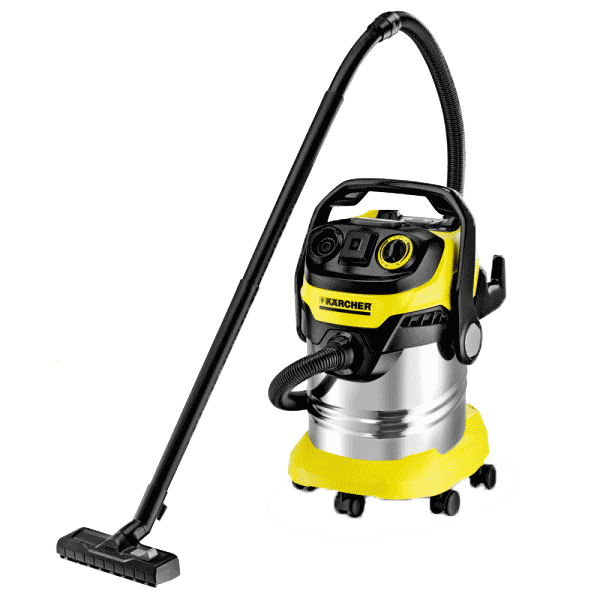A comprehensive guide to purchasing the best drum vacuum cleaner, with all its features and functions.
The Complete Guide to help you choose the Best Drum Vacuum Cleaner
by the Real Experts of Cleaning Machinery
The drum vacuum cleaner is an indispensable tool for those who need a more powerful and more advanced solution than the standard equipment for indoor cleaning (such as canister vacuum cleaners or electric brooms), which can work on large surfaces and collect – in addition to dust – liquids, solids and, in some cases, as we will see later, ashes.
This type of equipment enables large quantities of both solid waste (such as plastic, paper, metals, construction debris, etc.) and liquid waste (whether watery or oily) to be collected. They are therefore suitable for effectively vacuuming up virtually any type of dirt.
The main characteristics that distinguish drum vacuum cleaners from normal domestic vacuum cleaners are certainly the suction power and the type of material that can be vacuumed, but there are obviously other differences
So let’s take a closer look at the specific features of these vacuum cleaners, in order to find out how to choose the best drum vacuum cleaner.
CONTENTS
1. What does a drum vacuum cleaner look like?
The drum vacuum cleaner mainly consists of:
- a drum, usually cylindrical, which acts as a collection canister where all the materials drawn in (solids and/or liquids) are stored;
- one or more electric motors which, once started, generate suction;
- one or more filters, whose function is to prevent the finest dirt particles from circulating back into the air immediately after being vacuumed; these can vary depending on the type of material to be aspirated:
- these are usually foam filters for liquids and cloth/cartridge filters for dusts;
- there are also other types of filters, that can extend their filtering action to both dusts and liquids;
- for people who suffer from allergies, the most suitable type is the HEPA filter (High Efficiency Particulate Air), which traps allergens and fine dust;
- a suction hose, to which extensions, brushes and various accessories can be attached;
- fixed and/or swivelling wheels (and sometimes a handle at the top) for easy transport.
The operation of a drum vacuum cleaner is quite straightforward: the electric motor, once activated, generates a vortex that, through the suction hose, allows all the dirt to be drawn into the collection drum; the air sucked in together with the dirt passes though a special filter and, once freed from the dust it was saturated with, is then expelled outside.
2. The different uses of the drum vacuum cleaner
There are different types of drum vacuum cleaners, which differ from each other depending on their function. Knowing these classifications will certainly help you to understand which product to choose according to your requirements.
2.1 Vacuum cleaners/ Wet and Dry vacuum cleaners
Although there are also drum vacuum cleaners on the market that only have a vacuum function, they usually perform both a dry vacuum cleaner and a wet vacuum cleaner function, allowing them to remove all types of dirt, whether in solid or liquid form, which is what makes them a “wet and dry vacuum cleaner“
2.2 Carpet cleaners
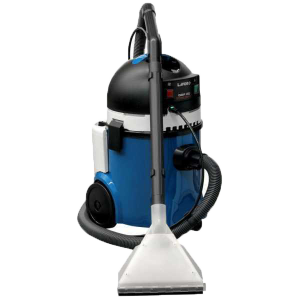
Carpet cleaners (also generally known as upholstery cleaners) are similar to spray extraction cleaners and are designed with an injection/extraction function to allow you to thoroughly wash textile surfaces such as car interiors, upholstery, carpets and rugs.
The presence of a special liquid injector nozzle – thanks to the combined action of water and detergent, pre-loaded in special containers – and the powerful and rapid suction of the same, make it possible to perform an excellent washing action with the simultaneous drying of the surface.
Some models of carpet cleaners have a double container: one to keep the mixture of water and detergent needed for washing, the other to collect the dirty water resulting from cleaning.
The higher-performance models are mainly suitable for professional use (e.g. for cleaning companies).
2.3 Multifunctional drum vacuum cleaners + ash vacuum cleaners (3in1 or 4in1)
There are also multifunctional drum vacuum cleaners on the market which – in addition to collecting dust, solids and liquids – are also capable of vacuuming ash, a function provided by filters suitable for fine dust. Some models even enable hot ash to be vacuumed out (in this case, thanks to a metal filter). These types of cleaning equipment- wet/dry vacuum cleaners, spray extraction cleaners and also ash vacuums – fall into the category of 3in1 multifunctional drum vacuum cleaners.
If, in addition to the 3 functions listed above, the drum vacuum cleaner can also feature a blower function, this is known as a 4in1 multifunctional drum vacuum cleaner. In this case, the suction hose is connected to the air outlet nozzle to blow away dust and light materials (such as ashes or leaves) or to move them from one place to another, before they can be vacuumed and finally disposed of. This function is particularly useful when it is not possible to vacuum and collect certain materials or when direct suction is particularly difficult (e.g. when dirt is trapped in narrow spaces).
3. Domestic and professional use
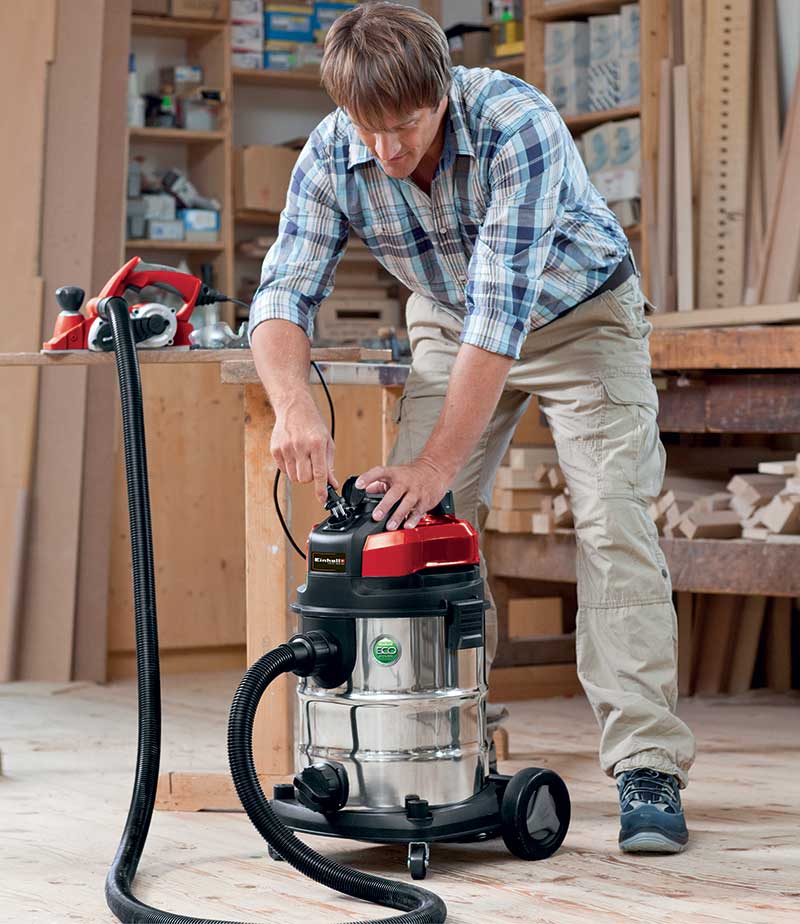
The drum vacuum cleaner is intended both for domestic use (in the home, garage or for car cleaning) and for professional use (in workshops, small construction sites, cleaning companies, car washes, etc.). Of course, there are versions that are more suitable for one or the other area of use.
Drum vacuum cleaners for home use
For domestic/hobby use, it is not necessary to have a top-of-the-range product that offers the best performance in terms of power, capacity, etc. Even less powerful and more compact drum vacuum cleaners (and therefore smaller in size, an aspect that should not be underestimated in spaces that are not too large, such as a house) can be optimal for domestic use, such as for cleaning the garage or the basement.
A drum vacuum cleaner with a medium drum capacity (e.g. 20 litres) can be considered more than suitable for domestic cleaning.
Heavy-duty drum vacuum cleaners
On the other hand, when working on large surfaces with large quantities of dirt to be removed, it is advisable to use a heavy-duty (or industrial) drum vacuum cleaner, which has high suction power and a larger drum capacity, without therefore having to be emptied continuously.
They are mainly intended for professional activities (such as car washes, cleaning companies, craftsmen’s workshops, etc.) which need to make intensive and prolonged use of them, and which also pay particular attention to a very high level of performance.
4. Which technical features to take into account
4.1 Number of motors, max. power (watts) and air flow rate (litres/second)
The suction power is perhaps the technical characteristic to which one pays most attention when talking about drum vacuum cleaners and, more generally, about canister vacuum cleaners.
Drum vacuum cleaners (especially heavy-duty ones) are able to reach high levels of suction power thanks to the presence of several motors, which can be operated simultaneously. On the market, there are drum vacuum cleaners with 1, 2 or 3 motors that can achieve a maximum total power (measured in watts – W) of up to 3000W. The higher the motor power, however, the higher the electricity consumption.
Besides, contrary to what one might think, motor power is not directly proportional to suction power!
In fact, suction power should not be confused with air flow rate, which is a measure of the volume of air drawn in.
This is commonly expressed in litres per second (l/s): the larger the air outlet opening of the hose, the greater the volume of air that is aspirated and the lower the power required to vacuum the dirt.
Basically, the air flow rate can be considered an important indicator of the efficiency of an appliance, also in terms of energy saving.
Therefore, if the vacuum cleaner is not built to the highest standards, it will consume more energy without necessarily delivering the best performance.
Using a vacuum cleaner with a higher rate of air flow means that you can remove dirt with fewer passes and, in the case of large areas or large quantities to be vacuumed, with considerable savings in time (and consumption).
NOTE – One aspect that is becoming increasingly important to consumers is the awareness of energy saving. Since – as we have seen above – greater suction power almost inevitably corresponds to greater energy consumption, there is a growing tendency to dispense with some of the advantages/performances of an appliance, for example by giving up a few watts of power, and to turn to “optimised” products that still allow good levels of performance to be achieved.
In the field of manufacturers of vacuum cleaners (and more), special mention should go to Kärcher, which has always been attentive to the issue of energy saving and is continually designing and manufacturing appliances that move in this direction.
4.2 Drum capacity (litres)
The larger the canister, the greater the possibility of working without the need to empty it. However, it is important to avoid filling it to capacity because an overfilled drum will tend to hamper the suction power of the appliance, reducing its efficiency.
On the market, you can also find large-sized drum vacuum cleaners with a capacity of up to 70-80 litres: these are certainly large, but obviously bulky and unwieldy.
Unless they are used for heavy-duty or even industrial purposes, the average user will easily be satisfied with an appliance that features a considerably smaller canister capacity: 15-20 litre drums can do the job very well in most situations.

4.3 Housing material
The main element in the structure of a drum vacuum cleaner is definitely the drum. There are canisters made of plastic material or in steel (or stainless steel).
The plastic drum is rather lightweight and flexible and is less likely to show deformation due to impacts, thus ensuring greater and more durable integrity. It also provides excellent resistance to contact with chemicals.
The steel canister, especially if made of stainless steel, is certainly heavier but also more valuable and has a better aesthetic impact (particularly suitable for use in public spaces). Although it is sturdier and has a higher level of unbreakability, it is more prone to showing signs of bumps and scratches resulting from impacts.
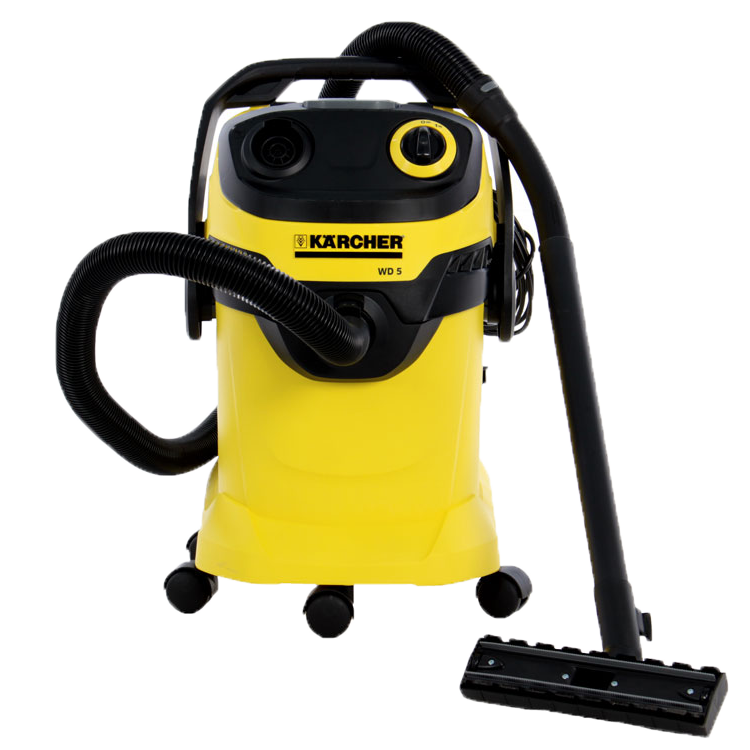
Plastic drum 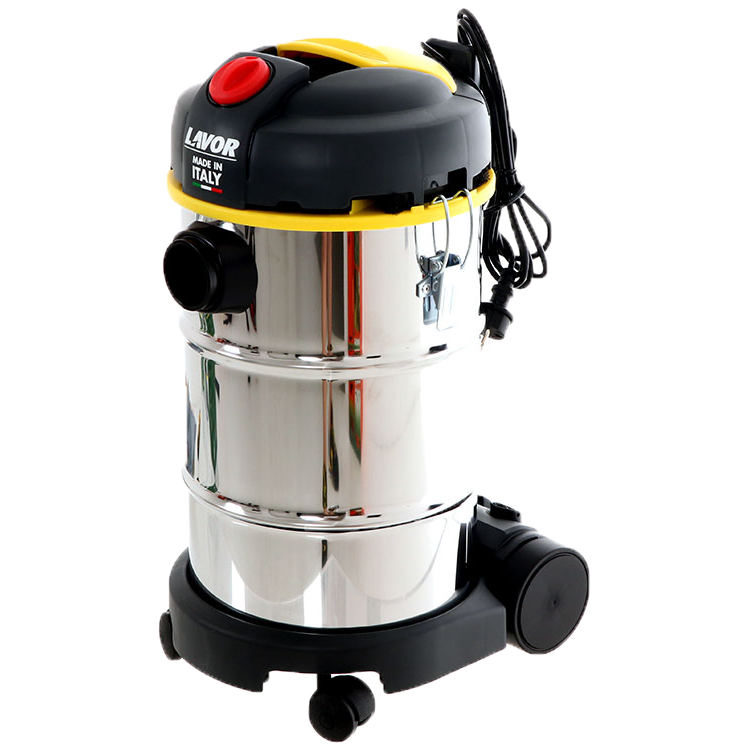
Stainless steel drum
5. Additional functionalities
Let’s take a closer look at the most important accessory functions to help you choose the best drum vacuum cleaner.
(NOTE: These functions may or may not be present in the various models)
5.1 Power tools socket
A very useful feature, especially when the drum vacuum cleaner is used in the working environment, is the presence of a schuko socket fitted to the appliance to which a power tool (such as a drill, sander, electric saw, etc.) can be connected, with the possibility of directly vacuuming the dust created during the action of the power tool.
This function is particularly suitable for operators who use the drum vacuum cleaner on construction sites, workshops, carpenters’ shops (and other types of craft activities).
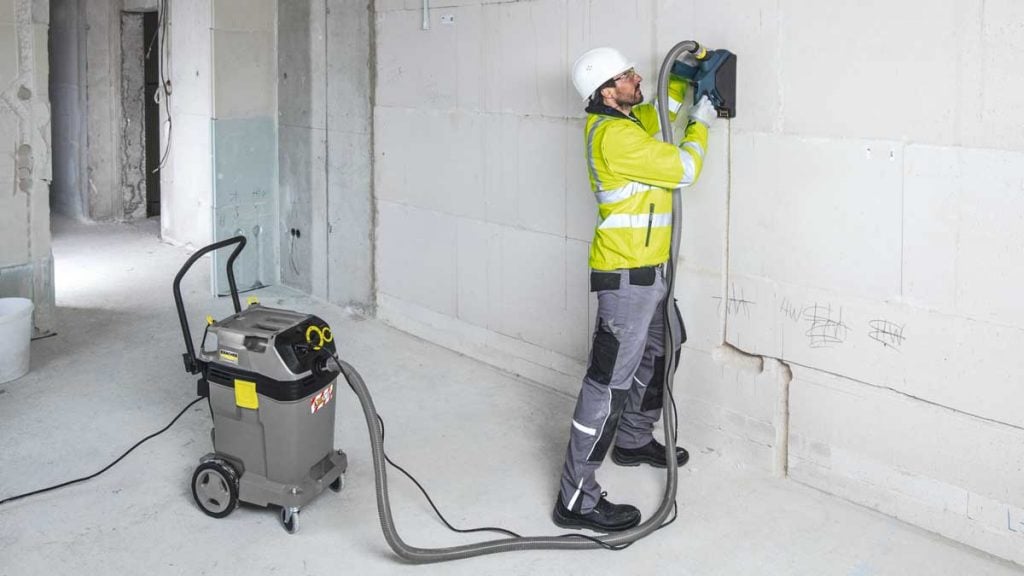
5.2 Filter shaker
The filter shaker is an integrated filter cleaning system that ensures a significant increase in the service life of the drum vacuum cleaner and does not require user intervention inside the canister.
There are different types of filter shakers, depending on the activation and operating mode:
MANUAL: activated by manually operating a lever (horizontal or vertical); this simple action shakes the filter and allows the dust to fall into the collection unit.
SEMI-AUTOMATIC: is activated manually by pressing a button which, when the motor is switched off, triggers a reverse air flow that shakes and cleans the filter.
AUTOMATIC: operated by means of a knob selector switch, when the filter begins to lose efficiency, the motor is switched off and a jet of compressed air is generated to hit and clean the filter.
PNEUMATIC: by manually pressing a button, a pneumatic cylinder periodically shakes the filter with a vertical movement that dislodges dust and debris from the filter.
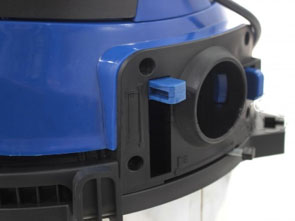
Vertical lever 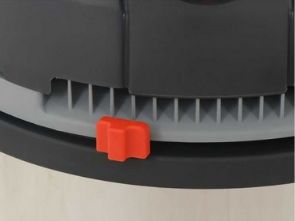
Horizontal lever 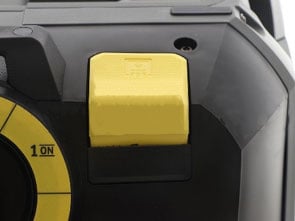
Semi-automatic 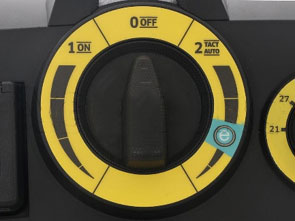
Automatic 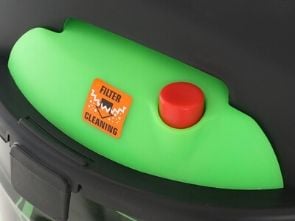
Pneumatic
5.3 Drum with tilting system/ Water drain screw
A practical handle allows the drum to be tipped over, making it extremely easy to empty and clean; this function is particularly useful when discharging powders and solids.
For liquids, on the other hand, some models feature a drain screw that allows for quick emptying.
5.4 Parking function
This function allows you to store (“park”) the suction hose on the drum vacuum cleaner whenever you need to take a break or when, for example, you need to move an object in order to better vacuum the dirt.
5.5 Tool holder
This is an accessory compartment located at the base of the drum vacuum cleaner, which is very useful when you have several accessories that need to be within easy reach at all times: before, during and after using the drum vacuum cleaner.
6. The main accessories
A good drum vacuum cleaner is usually equipped with a set of accessories to perform different tasks, depending on the situation. Most accessories are supplied as standard and include:
- the suction hose, which may be telescopic or fixed
- one or more extensions to increase the length of the hose
- brushes in various shapes and sizes to collect dust and liquids, suitable for use on textiles/upholstery and delicate floors
- different types of nozzles to reach any space, even the narrowest and most difficult ones (such as floor grout lines, the space between sofa cushions or even the hidden corners of car interiors)
- some spare filters



